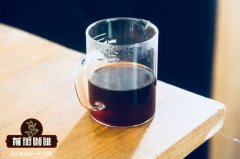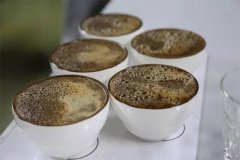What is 90+ beans its flavor taste
Just as Dev can only be called chocolate-flavored candy, instant coffee can only be called coffee-flavored soft drinks. 90 + coffee beans are the symbol of the best honor in the coffee industry.
"90 +" does not refer to all coffee with a rating of more than 90, it refers to a top range of 13 flavors. Sometimes they haunt different estates, and they have a variety of taste characteristics. When processing, baristas will separate these coffees one by one according to variety, climate, and timing of freshness. They are like works of art that tend to be perfect. Baristas take painstaking efforts to make them taste the best and present them in the most perfect posture.
The pursuit of the ultimate flavor of "90 +" is very admirable, and their sustainable development model and environmental protection operation are also the learning goals of many coffee producers. Since the company was founded in 2006, the young company has made them known to coffee industry people all over the world in just a few years. The coffee series that made its debut in 2007 was immediately regarded as a precious show by coffee experts.
Excellent quality
Joseph Brodsky, the founder of 90 +, discovered early that all the world's high-quality raw coffee beans originated in Ethiopia, and its different flavors of many different varieties are no less than 10, 000 grapes into 1 million different wines. Ninety percent of the raw beans are from the original varieties of Ethiopia, including the Manor of Panama (Gesha) is also the original variety of Ethiopian heirloom (Heirloom) transplant. The processing process is 90 + specialty, will separate these coffee according to variety, microclimate, fresh time one by one, one by one, specially designed processing methods for each taste, to achieve a taste feature, just like the big-brand design, painstaking research, painstaking efforts to complete a handicraft close to art. Natural products go through a lot of refinement and improvement, and finally reach the most beautiful posture before presenting the content to everyone.
Now many stores are after Ninety Plus (90 +) coffee, but what is Ninety Plus (90 +) coffee, how to choose, how to buy, when you buy 90 + coffee, how to monitor, how to introduce to others, the following is a brief introduction of 90 + coffee, to help you better choose good coffee.
Joseph Brodsky founded Ninety Plus (90 +) in 2006, and Joseph began his journey when the Geisha species appeared in Panama in 2003 and 2004, but when he didn't find the result he expected in Panama, he had another idea that there may still be untapped potential among the more than 10, 000 varieties of coffee in Ethiopia. In order to ensure quality, 90+ adopts a cooperative model with local manors, with complete control from planting, sampling and harvesting to subsequent processing and cup testing. 90 + exclusive Profile Processing ensures that each coffee bean has a unique and stable flavor trend and quality, while 90 + coffee is unique in the market with the marketing method like high-end red wine.
The nomenclature of 90 + beans is completely different from that of general boutique beans. First of all, unlike the usual names of producing areas and manors, each bean is named according to its flavor. For example, the famous Nekisse is originally intended to take its name from Shakisso's nectar. The naming of 90 + usually starts with the concept of flavor, then the name, and then the choice of producing areas and cooperative farms. In this respect, it is very different from the general boutique beans and is a brand with boutique management style.
It is not difficult to find that usually beans have the letters N, H or W, such as Ethiopian Yiagacheffe G3 N, which is commonly seen in the market, where N stands for Natural. H = Honey (honey treatment) and W = Washed (washing). Here, 90 + also has a different view, they think that rather than using the method of treatment to distinguish beans, it should be distinguished by the trend of flavor. Generally speaking, each treatment of beans will have a more representative flavor, such as:
Insolation: unrestrained fruit aroma
Honey treatment:: the sweetness is outstanding.
Washing: the flavor is relatively clean
However, 90+ believes that sometimes there will be the same flavor trend under different treatments, for example, the flavor performance of beans treated with honey may be similar to that of washed beans, so they have introduced three basic flavor labels of N2, H2 and W2, which are distinguished by the intensity of fruit aroma and taste:
W2: (Low) low fruit tonality, emphasizing brightness, acidity and floral aroma

H2: (Moderate) moderate fruit tonality, emphasizing sweetness, fruit taste (non-aroma) and tea flavor
N2: (High) strong fruit tonality, emphasizing unrestrained flavor, sweet and sour, jam and dried fruit.
In 2011, in order to improve the stability of raw beans in Panama during the drying stage, Joseph developed a solar drying system inspired by a wood drying chamber with the University of Wisconsin in the United States, and named this exclusive treatment Solkiln? (SK). Of course, the beans after this special treatment are very expensive, and because of the space they can hold, the output is very small.
Finally, 90 + beans also have a scoring system that is different from the usual 100 points. The main reason is that beans produced by 90 + should all exceed 90 points on the cup test, and their grades are based on three factors: flavor, cost and output:
Level 7: special flavor, meticulous and impressive
Level 12: besides being impressive, it needs to be topical.
Level 21: a rare Level 7 with a flavor that usually surpasses that of Level 7.
Level 39: Level 12, which has low yield, has a higher flavor than Level 12.
Level 95: at present, the highest grade, from dried incense to the entrance, has a great change and impressive, and the output is very rare.
The discovery and development of good coffee is certainly what everyone would like to see, but very often, when the boutique becomes industrialized, the accompanying decline in quality is inevitable. I still hope that everyone will choose rationally and not blindly pursue the brand. The most important thing is to choose a good coffee that suits you, and the quality is the most important.
Important Notice :
前街咖啡 FrontStreet Coffee has moved to new addredd:
FrontStreet Coffee Address: 315,Donghua East Road,GuangZhou
Tel:020 38364473
- Prev

Ecuadorian coffee Ecuador Galapago coffee introduction
Professional coffee knowledge exchange more coffee bean information please follow the coffee workshop (Wechat official account cafe_style) Galapagos means "tortoise" in Spanish, the island has the famous Galapagos tortoise. Located in the Galapagos Islands, Ecuador, it is recognized by the United Nations Educational, Scientific and Cultural Organization (UNESCO) as the World Natural Heritage site of human culture. it is prohibited to use any chemical fertilizer.
- Next

History of Panama
Coffee was introduced to Panama in 1780, when Europeans brought in the first Typica species. The history of Panamanian coffee begins. For Panamanians at the time, the drink was both novel and mysterious, and not only quickly conquered people's consciousness, but also caused the locals to start growing coffee trees in general. Riding the third wave of coffee aesthetics
Related
- Beginners will see the "Coffee pull flower" guide!
- What is the difference between ice blog purified milk and ordinary milk coffee?
- Why is the Philippines the largest producer of crops in Liberia?
- For coffee extraction, should the fine powder be retained?
- How does extracted espresso fill pressed powder? How much strength does it take to press the powder?
- How to make jasmine cold extract coffee? Is the jasmine + latte good?
- Will this little toy really make the coffee taste better? How does Lily Drip affect coffee extraction?
- Will the action of slapping the filter cup also affect coffee extraction?
- What's the difference between powder-to-water ratio and powder-to-liquid ratio?
- What is the Ethiopian local species? What does it have to do with Heirloom native species?

